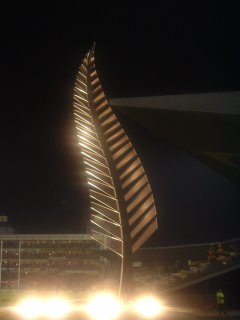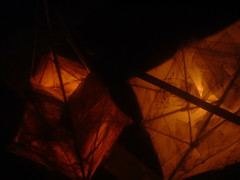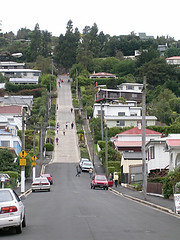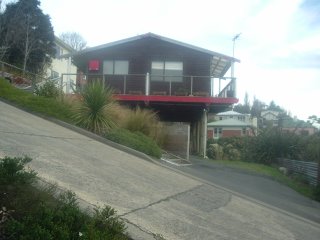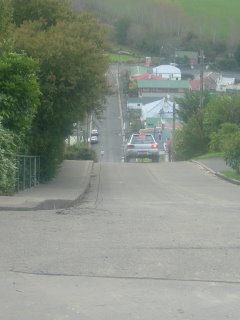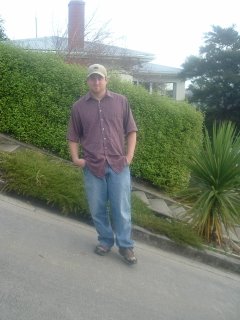It's terrifying.
Standing over a 440-foot drop, in a metal pod suspended by cables. A stretchy cord attached to you by a harness you're not sure anyone really checked was on properly, and a couple of bulky pads around your legs, which are held on by velcro.
You're ferried to the suspended pod by a open-air gondola, with a metal grate floor so you can see all the way down. Then suited up inside the pod, which seems to have as much glass as metal and wood for flooring.
When your name is called, you make your way to the side of the pod without a wall. Your legs are shackled to the cord, so you can only inch forward in a waddle. This is unnatural, so you have to look down. You don't want to look down.
The crew tells you to put your toes over the edge. When you feel you're close enough to the edge, they still think you're a long way away. As you inch forward, you have to look down to control your feet. The ground is more than 400 feet away. It's enough to kick in several survival instincts, all of which don't want to be near that edge. No matter how calm you thought you were, your nerves are wracked seeing the drop.
When you finally get to the edge, you're not sure you're going to be able to jump. You look down; you know you won't be able to jump. You look straight ahead, at a point on the hill in front of you. You hear the man who led you out to the edge count down - "one, two, three." You don't think, you just look straight ahead and jump forward.
Well, they tell you to jump out and away. I didn't, even though I meant to. I bent my legs and leaned forward, preparing to straighten my legs and propel my body forward. What happened instead was I started to fall, looked down, and my body froze. It felt like I jumped, so I didn't know it at the time, but the company videos the whole thing. When I watched the video, I realized I actually fell in that same legs bent position, halfway through the jump.
I'd watched the promotional videos of people jumping before I jumped. I knew when you jumped, your body was parallel to the ground. You fell that way until you dropped far enough for the slack in the bungy to play out. Then the cord attached to your feet caught, and you fell the rest of the way head-first.
That's what I was waiting for when I fell, to swing over and start to fall head-first. It's odd that position would be more comforting, but at least then you know the equipment is working.
The brochures tell you there's eight seconds of free-fall, but it's actually eight seconds of falling until the bungy reaches its full stretch and starts to pull you back up. It's probably closer to two, maybe three seconds of free fall before the cord starts to catch you.
Those two or three seconds felt like 20 as I fell. If you've ever had a falling dream, the kind you wake up from just before you hit, you know exactly what it felt like to fall toward that river bed. I was making a noise, something between a groan and a yell, as I just seemed to fall. My brain tensed. I was falling.
Then, of course, the bungy caught. I swung down and went head-first. When you reach the bottom of the cord's stretch, they say you're about 10 meters off the river bed. I didn't notice. I did notice a bit of pressure, and one contact lens shifted slightly. On my way up, I was just glad I hadn't lost the lens. Then I reached the top of the bounce and went weightless, which was an odd, but expected, feeling. Then another drop I barely noticed. At the top of the second bounce, they had briefed us beforehand, we had to reach to our left knee, grab a strap there and yank it away from our body. This would release our legs from the cord, leaving us suspended by a chest harness as we were pulled back up to the pod. Otherwise, it would be a slow lift feet-first, which didn't seem a pleasant prospect.
Once I pulled the foot release, it was over although I was still dangling in mid-air a couple hundred feet above the ground. At that point, I was gripping the point where the cord attached to my harness and breathing the quick breaths of a post-adrenaline rush. When I was hauled back up and released, my legs were shaking so I could barely stand up. As I watched the next few jumpers through the glass in the floor, I had to kneel down to steady myself.
I have now jumped out of a plane at 12,000 feet and bungy jumped from a pod 440 feet high. The bungy jump was, by far, harder. It was more terrifying and it wasn't as exhilarating afterward.
When you skydive, at least for the first time, you're attached to an instructor. He does all the jumping; you don't really have any control of the process once you're in the plane. Even if it was up to you to do the jump, at that high up the ground is more of an abstract concept than a reality. Free fall at that height doesn't feel like falling; it's like something completely different, a singular sensation. It doesn't feel like you're falling to the ground as much as it feels like the wind is rushing up past you.
But to jump off anything a few hundred feet above the ground, your brain has a very good idea of just what the ground below you means. It's not abstract at all. If you have any fear of heights or of falling, it kicks in big-time.
When you sky dive, it doesn't really feel like the ground is getting close at all until the last few hundred feet. After leisurely checking out the scenery as you're suspended by a parachute, you have a second or two of the ground rushing up at you, then your down. There's adrenaline, but it's a calm rush. Afterward you're on a high, grinning uncontrollably and excited for the rest of the day.
The Nevis bungy also involved falling, but it was an entirely different experience. It was sheer terror. You have to walk out to the ledge, you have to jump. The whole time the ground is definitely rushing up at you, and you're rushing down to it. It's not a calm adrenaline rush, it's a sudden, harsh, drenching of your panic centers. I was in a group of about 20 jumpers. After each person jumped, there was some of the nervous laughter that comes after any intense experience. Most people had a hard time standing for a few moments, as their legs were shaking. But the euphoria accompanying the end of a skydive was nowhere in sight. Immediately after they jumped, people were hyper, anxious to talk about the experience. But on the bus ride back to town, a half hour or 45 minutes after the jump, people were silent, some sleeping, their energy drained.
This is not to say I regret doing the bungy jump. I'm very glad I had the experience. It was something I'd wanted to do since I got to New Zealand. This is the country that invented commercial bungy jumping. And if I was going to do it, I might as well do the biggest. I even have a desire to do it again.
All I'm saying is I can't imagine I'll ever forget the feeling of falling. In fact, when I went to sleep that night I woke up, twice, with falling dreams. They weren't necessarily nightmares. It wasn't that I thought I was going to hit the ground - I had a bungy cord attached.
It was simply, exactly, the feeling of falling.
 The archived ramblings of my time as a world traveler up to my current life in Washington, D.C.
The archived ramblings of my time as a world traveler up to my current life in Washington, D.C.